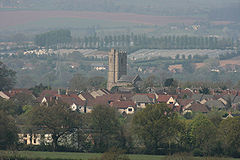
Back Wellington, Somerset Afrikaans ويلينجتون (سوميرسيت ويست اند تاونتون) ARZ ولینقتون، سامرست AZB Wellington (parokya) CEB Wellington, Gwlad yr Haf Welsh Wellington (Somerset) German Wellington (Somerset) Spanish ولینگتون، سامرست Persian Wellington (Somerset) French Wellington, Somerset Irish
| Wellington | |
|---|---|
 Wellington from Chelmsine | |
Location within Somerset | |
| Population | 16,669 (2021 Census)[1] |
| OS grid reference | ST140203 |
| Civil parish |
|
| Unitary authority | |
| Ceremonial county | |
| Region | |
| Country | England |
| Sovereign state | United Kingdom |
| Post town | WELLINGTON |
| Postcode district | TA21 |
| Dialling code | 01823 |
| Police | Avon and Somerset |
| Fire | Devon and Somerset |
| Ambulance | South Western |
| UK Parliament | |
Wellington is a market town in Somerset, England. It is situated 7 miles (11 km) south west of Taunton, near the border with Devon, which runs along the Blackdown Hills to the south of the town. The town had a population of 16,669, which includes the residents of the parish of Wellington Without,[3] and the villages of Tone and Tonedale.
Known as Weolingtun in the Anglo-Saxon period, its name had changed to Walintone by the time of the Domesday Book of 1086. Wellington became a town under a royal charter of 1215 and during the Middle Ages it grew as a centre for trade on the road from Bristol to Exeter. Major rebuilding took place following a fire in the town in 1731, after which it became a centre for cloth-making. It is possible that the fire referred to here was actually in Tiverton, Devon which has details of a major fire in the same year. Further information on a major fire in Wellington at this time cannot be found.
In 1809, the Crown referenced Wellington when creating a viscountcy for the eventual Duke of Wellington, Arthur Wellesley, after his victory at the Battle of Talavera in the Peninsular War. When the title's name was being considered, Arthur's brother, Richard Wellesley, Earl of Mornington, found an available manor in the parish of Wellington, a name close to the family name. Richard oversaw the manor's purchase while Arthur commanded the army in Spain against the French. The Wellington Monument south of Wellington commemorates Arthur.
The Grand Western Canal reached the town in 1835 and then the Bristol and Exeter Railway in 1843. The town's own railway station survived until 1964. Wellington was home of Fox, Fowler and Company, which was the last commercial bank permitted to print their own sterling banknotes in England and Wales. In the 20th century closer links with Taunton meant that many of the residents of Wellington commuted there for work, and the M5 motorway enabled car journeys to be made more easily.
Local industries, which now include an aerosol factory and the Relyon bed manufacturers, are celebrated at the Wellington Museum in Fore street. Wellington is home to the independent Wellington School, and state-funded Court Fields School. It is also home to a range of cultural, sporting and religious sites including the 15th century Church of St John the Baptist.
The capital city of New Zealand is named after Arthur Wellesley, 1st Duke of Wellington, being recognised as having some influence in the company that founded the New Zealand town. The New Zealand capital therefore takes its name ultimately from the English town of Wellington in Somerset.
- ^ "Wellington". City population. Retrieved 25 October 2022.
- ^ "Wellington Town Council Website". Wellington Town Council. Retrieved 11 January 2022.
- ^ "Statistics for Wards, LSOAs and Parishes — SUMMARY Profiles" (Excel). Somerset Intelligence. Archived from the original on 4 January 2014. Retrieved 4 January 2014.
© MMXXIII Rich X Search. We shall prevail. All rights reserved. Rich X Search
